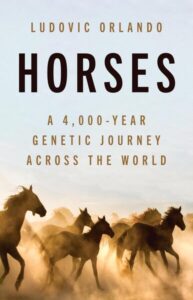Some myths take longer to die than others. For students of equine history, the passion that these animals inspire in their owners and breeders often act as a veil, impenetrable for scientists and historians trying to get to the facts. In Horses, Ludovic Orlando, who has been gathering the facts jaw bone by jaw bone for two decades, deploying the latest technology, appears to have pierced the veil, finally, though with many a surprising turn to keep the readers on edge, as though enjoying a detective novel.
Many of the stories told here have appeared in scientific magazines since the publication of “The origins and spread of domestic horses from the Western Eurasian steppes” in Nature magazine, in 2021. Orlando enlivens these stories, however, by describing his travels to and from England, to the steppes of Kazakhstan and on to the Siberian tundra, where he has his fruitful encounters with colleagues, including William Taylor, Pablo Librado, Alan Outram and Pavel Kuznetzov.
The real hero of the story is the methodology.

The real hero of the story, however, must be the methodology that this team has used. They collected 264 fragments of equine remains. They then used carbon dating to roughly sequence the chronology of each item. By extracting the DNA from the remains, they could create a family tree to see which items reflected ancestors of others. Finally, using a model based on Bayesian logic—so complex that a powerful computer requires weeks to crunch through the results—they created a map of dispersal that can account for the presence of the remains in both time and space. As a result we can see, as it were, a movie showing ancient horses migrating from North America to Asia, from Central Asia to Europe, or from Iran to the west. We can follow the ghostly trails of wild horse herds, migrating, horse breeding peoples, and horse dealers on the Silk Road. The end model has powerful explanatory value in interpreting the origin myths of the species and its storied breeds.
Among the myths Orlando dispatches are the Iberian origin hypothesis, the family tree of the Przewalski, the Kurgan hypothesis, the size of Medieval destriers, and the antiquity of the Arab horse. In each case the author exhibits respect for the received traditions, and allows a little bit of wiggle room in his final conclusions to allow the traditionalists to withdraw from the arguments with dignity.
As an example of his approach, we read how he invited Yvette Running Horse Collin, a scholar from the LaKota people, to investigate whether the Western horse had any indigenous, as opposed to Spanish, ancestry. Scholarly opinion for years held that the horse had died out in the equid birthplace, North America. Collin upheld the view, based on her people’s traditions, that their horses had part indigenous ancestry, with the standard view a mere product of colonialism. The problem for Collin is the several thousand year gap in the fossil record. She argued that the absence of evidence is not evidence, and that the prevailing view may have induced scholars to overlook or mis-interpret available remains. Orlando met her more than half way, introducing a new technique of examining the soil for micro-remains of horses, in the absence of bones. This technique indeed suggested the survival of the horse much later than scholars had earlier believed.
While welcoming Collin to his lab in France, Orlando warned, if her hypothesis is validated, “your model will be accepted by Western science. But if we don’t find a direct genetic link, we will have to report that the version officially defended by Western academia is not a myth.” After comparing extensive collections—including those of William Taylor and from a sacred, LaKota horse burial site—Orlando was unable to find significant evidence of indigenous DNA. He adds, “For now.” He also observes that with the number of horses brought over by the Spanish, any native horses would have had only a very diluted influence on the offspring—less than 1%. So on the one hand, Collin does not go back to the USA empty-handed, but on the other hand, there’s no doubt that the Spaniards’ horses revolutionized the life of her people, however much they may have venerated scarce wild horses as part of their traditions.
The clarity around the early history of Eurasia based on this research is an intellectual revolution in itself.
Of course, the major discovery from the body of work is that today’s horses descend from ancestors domesticated on the steppe between the Don and the Volga rivers. Horse-herders learned how to breed animals both more docile and stronger-spined, facilitating intensive riding—which revolutionized everything: communications, religion, warfare, society, economics. These new horses replaced all the other horse breeds in Eurasia in the course of a few hundred years, an amazingly rapid innovation that can only be compared with steam or electricity in its impact. While the new horses did not lead the future speakers of Germanic, Latin, Celtic or Slavic languages into Europe (oxen had already taken them there), they did pull the chariots of central Asian warriors into Iran and India, later creating the cults of the Avesta and the Rig Veda.
The clarity around the early history of Eurasia based on this research is an intellectual revolution in itself. It shows that we must avoid the trap of separating STEM education from the humanities, for neither track could have cracked this mystery on its own.
Published in French in 2023, this work joins a number of titles dedicated to horses, including Taylor’s and this reviewer’s Raiders, Rulers, and Traders, which is deeply indebted to both these scholars’ research. Readers of Horses will be well rewarded by this story of science without triumphalism, but which nevertheless dissipates hoary myths and establishes a solid basis for the study of humans and horses across 4,000 years, largely coeval with civilization itself.


You must be logged in to post a comment.